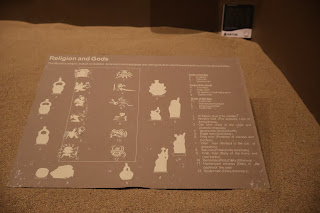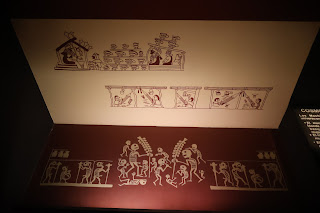The visitor enters the museum via a long ramp, which resembles the ascent to the ancient Mochica pyramids, until reaching the third floor where the main door is located. Before entering there is a dark glass structure that prevents the entry of ultraviolet rays and prepares our eyes to then enter the dark environment of “the tombs”. A glass door half gold and half silver, symbol of the concept of duality in the Mochica culture.
On this third floor, the thematic unity of the Mochica culture is presented, which contextualizes archaeological discoveries such as territory, evolution, social organization, agriculture and cultivated plant products, metallurgy, its most important monuments as well as the general presentation of the sanctuary of Sipan.
A second theme is the spiritual world of the Mochicas, their gods and concepts of life, from conception to death, which marks the transition to eternity. A large panel illustrates the Mochica worldview with the sky, the world of the living and the world of the dead that provide an introduction to the discovery of the royal tombs.
|
Plan of the third floor of the museum. |
Background and chronology
|
Location of Sipan in the valley of Lambayeque and current access |
|
Origins and predecessors |
|
Location in time |
Phases and social structure
|
Five stylistic phases
|
|
Social groups and stylistic phases
Phases
|
|
Phase I |
|
Phase II |
|
Phase III |
|
Phase IV |
|
Phase V |
|
Prisoner |
|
Soldier |
|
Woman |
|
Man of the village |
|
The Lord |
Agriculture
|
Agriculture
|
|
Agricultural products
|
|
Corn |
|
Cucumber |
|
Pumpkin |
|
Pumpkin (Zapallo)
|
Fishing
|
Representation of a vessel and marine fauna |
|
Marine fauna
|
|
Fish |
|
Sea lion |
|
Fisherman |
|
Seabird |
|
Crab |
Domestic animals
|
Domestic animals bred and used by the Mochicas
|
|
A. Coastal Llama (as food and pack animal) |
|
B. Dog (pet) |
|
C. Domestic duc (food) |
Flora and fauna
|
Flora and fauna
|
|
A. Monkey |
|
B. Plants and birds in a river environment |
|
C. Lizard |
|
D. Lynx |
|
E. Coastal fox |
Metallurgy
|
Manufacture of gold ornaments |
|
Manufacture of gold ornaments
|
|
Gold nugget obtained from the river |
|
Silver (left) and gold-plated copper (right) |
|
Stone tools for gold rolling |
|
Molten copper metal |
|
Tool (left), weapon (center) and ornaments (right) |
|
Copper mineralized rock |
Architecture
|
Architecture |
|
Sipan 1700 years ago
|
|
Panorama of the scale model |
Religion and Gods
|
Religion and Gods
|
|
a. Ai-Apaec God |
|
b. Owl Man |
|
c. Iguana man |
|
d. Fox man
|
|
e. Deer man |
|
j. Humanized octopus |
|
k. Demoniacal fish |
|
Ai-apaec in mythical scene and Spider man
|
|
f. Ai-apaec in mythical scene |
|
l. Crab man |
|
h.i. Crab man (Bottom) |
Life and death
|
Life |
|
Death |
|
Breeding |
|
Childbirth |
|
Lactation |
|
Childhood |
|
Youthhood |
|
Adulthood |
|
Oldhood |
|
Announcer of death |
|
Announcer of death |
|
Announcer of death |
|
Type of Mochica tombs
|
|
Sipan tombs
|
|
Golden rattle |
|
Cosmovision
|
|
The gods lower the funeral bundle into a tomb |
|
Going down to the second floor |
See also
-
Royal Tombs of Sipan Museum
-
Royal Tombs of Sipan Museum - Second Floor
-
Royal Tombs of Sipan Museum - First Floor
Source
Location




















































































































































